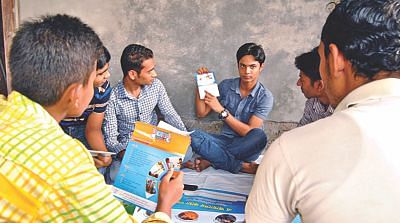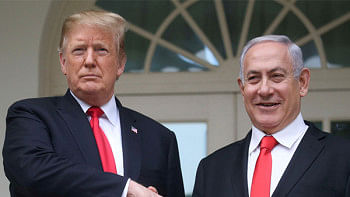Adolescents and young people of Bangladesh

Bangladesh has an adolescent and youth population of approximately 52 million, amounting to 1/3rd of the country's total population. This significant percentage, however, will not remain unchanged for very long and it is projected that by 2050, only 10-19% of Bangladesh's population will consist of young people (UNFPA 2014). What this means for a country like Bangladesh is that it needs to invest in the human capital of young people and focus on meeting their needs without further delay. It is only then the country will be able to reap the benefits of this investment by having a more educated, healthy and productive population during the second half of the century. Often referred to as the demographic dividend, what this means in simple terms is that investing in young people will contribute to economic growth, poverty reduction, falling fertility rates and better social indicators for the country.
The lack of access to high quality education, absence of decent work opportunities for youth, the unavailability of comprehensive health including sexual and reproductive health (SRH) services, the exclusion and marginalization from civic participation and policies and laws which act against the best interest of young people are but a few challenges which they have to contend with on a regular basis. In a context like Bangladesh, where socio-cultural beliefs, patriarchal norms, economic deprivation and difficulties in accessing quality information and services on sexual and reproductive health, directly affect young people, it becomes the responsibility of the development sector to advocate for greater investment in young people and support the Government of Bangladesh in their efforts to address issues which affect this cohort of the population.
UNFPA, with its focus on ensuring that every young person's potential is fulfilled, has varied interventions to address adolescent and youth SRH needs in Bangladesh. In order to meet young people's overall SRH needs and make available accurate and affordable information and services which are not judgmental, UNFPA works with a range of partners in different settings. Three of the most pressing issues which affect young people in Bangladesh, in relation to their sexual and reproductive health and rights are gender based violence, child marriage and associated teenage pregnancy and fertility. According to the Bangladesh Demographic and Health Survey(BDHS) of 2007, 35% of rural ever-married adolescents and 40% of urban ever-married adolescents have experienced some form of violence by their husbands in their current or most recent marriage. The Health Profile of Adolescents and Youth in Bangladesh published by the Government of Bangladesh, states that women aged 20-24 are more likely to have ever experienced physical violence than adolescent girls aged 15-19, indicating that older women have been exposed to the risk of violence for a longer time than younger women.
Closely linked to gender based violence and the discrimination faced by adolescent girls is Child Marriage. Child Marriage is a serious concern for Bangladesh with 65% of women currently aged 20-24, being married by 18 years (BDHS 2011), a statistic that has remains unchanged from 1999. According to the International Centre for Research on Women (2012), the prevalence of child marriage in Bangladesh is the highest in South Asia and even though poverty is not the only contributing factor, it is one of the strongest drivers for this high level of child marriage. The societal pressure to prove one's fertility, almost immediately after marriage, has resulted in Bangladesh also having high levels of teenage pregnancy and fertility. The adolescent birth rate, for girls between the ages of 15 and 19 years is 118 per 1000 women which is again the highest rate in the South Asian region. The high level of child marriage and associated teenage pregnancy results in many negative health and social consequences which include obstetric fistula and other pregnancy related morbidities, maternal mortality, neo natal/infant mortality, anemia and poor overall health of both the baby and the mother.
In addition to working with key line Ministries and NGOs to provide SRH services for young people, UNFPA also supports policy makers to integrate population dynamics in all planning efforts. Advocating and engaging with Parliamentarians to improve maternal health, eliminate child marriage and ensure young people's development is another area of UNFPA's work in Bangladesh. It is important to note that investing in meeting the SRH needs of adolescents and youth is but one aspect of ensuring their overall development. Whilst the sexual and reproductive health of young people is a key factor in their overall development, it is important to also invest in quality education for young people, including comprehensive sexuality education, decent employment opportunities which are free from gender based discrimination and violence and giving young people a platform to contribute to the formulation of long-term development plans. Young people have a right to quality education, decent work and comprehensive health services including sexual and reproductive health services and investing in young people is what will give hope to the next generation. It is this which should be the focus of all our development plans.
Adolescents and youth are a key focus for the UN and UNFPA – both globally and in Bangladesh. The recently presented UN Secretary General's Synthesis Report on the Post 2015 Development Agenda highlights and reaffirms UN's commitment to addressing youth issues and especially focuses on the importance of meeting the sexual and reproductive health and rights of adolescents and youth. As articulated by Mr. Ban Ki-Moon at the First Global Forum on Youth Policies in Azerbaijan, 'the leaders of tomorrow must be heard today' and we in Bangladesh need to pay close attention what Bangladeshi youth are telling us and invest in their 'today' so that their 'tomorrow' is one which is more equal, just and fair for all, especially for young girls.

 For all latest news, follow The Daily Star's Google News channel.
For all latest news, follow The Daily Star's Google News channel. 



Comments